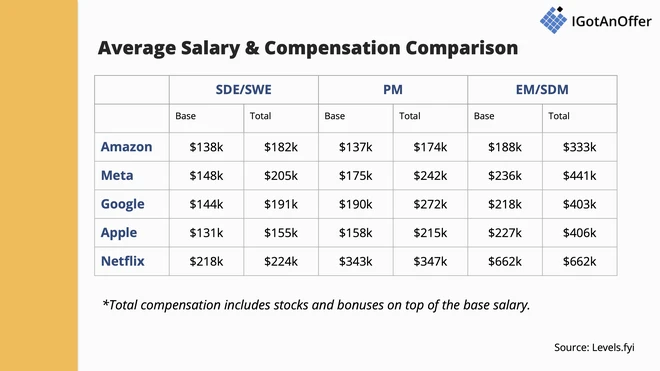Amazon’s interview process is long and difficult, and not knowing what steps to expect makes it even harder to prepare for.
We’re here to help. We work with 200+ ex-Amazon interviewers on our platform, who have helped thousands of candidates navigate the Amazon interview process.
Here’s what you need to know: Amazon’s hiring process has seven steps: resume screen, recruiter call, assessments, phone screen(s), interview loop, interviewer debrief/hiring committee, and salary negotiation. The entire process can take up to two months or more.
Unlike other FAANG companies like Meta or Google, Amazon places great emphasis on culture alignment. Expect to be assessed on your alignment with the company’s 16 Leadership Principles at every stage of the interview process.
- Step 1: Resume screen
- Step 2: Recruiter call
- Step 3: Assessments
- Step 4: Phone screen(s)
- Step 5: Interview loop
- Step 6: Interviewer debrief / hiring committee
- Step 7: Salary negotiation
Click here to practice 1-on-1 with ex-Amazon interviewers
But before we get into each step, let's get to know Amazon first.
About Amazon
Amazon was founded in 1994 as an online marketplace selling books. It has since expanded into a multinational company with e-commerce, cloud computing, and digital streaming as some of its top products.
Amazon is currently valued at $2.329 billion as a public company. It currently employs over 1.5 million people worldwide, with office locations in every part of the world. The majority of these employees are US employees. This makes Amazon the second-largest private employer and the largest job creator in the country.
Working at Amazon↑
Here are a few things about working at Amazon that make it unique from other top tech companies.
Customer obsession
This is obvious from reading Amazon’s mission statement ("Our mission is to be Earth's most customer-centric company”) and its first Leadership Principle (Customer obsession).
No matter what role you’re in, whether you’re a software development engineer, a product manager, or an account executive at Amazon, the customer-centric approach is expected to be central to all your initiatives.
Document culture
One of the most unique aspects of working at Amazon is its writing culture. Every meeting starts with a document, which attendees read for the first 20 minutes. They then spend the rest of the scheduled meeting analyzing the document and giving feedback. Afterwards, the document writer revises it before distributing it in its final form.
This is why you’ll find that several roles will require a writing assessment as part of the application process.
Top-down decision-making
Unlike Meta and Google, Amazon follows a top-down decision-making process, giving the executive team a relatively high degree of control.
The company does give its function-based teams and regional groups some room to experiment and innovate to help the global company address the rapidly changing needs of customers. As ex-Amazon interviewer Dessy explained to us, teams at Amazon operate relatively independently, almost like their own start-ups.
Return-to-office policy
Starting in 2025, Amazon has mandated a strict return-to-office policy, with CEO Andy Jassy saying that in-office work is best for strengthening company culture and teamwork.
The policy requires remote workers to relocate closer to a designated office hub within two months or face potential termination.
Great salaries
Of course, the excellent salaries on offer are likely part of your reason for applying to work at Amazon.
How do Amazon's salaries compare to those of other FAANG companies? Here’s a comparison table featuring the average salaries and compensation for software engineer, product manager, and engineering manager roles.

One thing to know about Amazon job offers is that they have very firm base salary caps, compared to Google and Meta. Still, they do have room for negotiation, so make sure you negotiate if you get an offer (more on this later).
Now let’s get into the Amazon recruitment process.
7 steps of the Amazon recruitment process
Step 1: Resume screen↑
First, you’ll need to convince recruiters that you have a strong enough profile to be invited to the first round of Amazon interviews.
You will either submit your application through Amazon’s jobs portal, or you will have been contacted directly via email or LinkedIn by an Amazon recruiter.
In either case, you will need a strong resume to impress them.
This is an extremely competitive step, as we’ve found that ~90% of candidates don’t make it past the resume stage. To help you put together a targeted resume that stands out from the crowd, follow the tips below.
Tips on crafting a resume
- Study the job description: The work experience that you display on your resume should relate directly to the role qualifications that you’re applying for. Incorporating job-specific keywords also helps you pass the applicant tracking system (ATS).
- Be specific: Use data to back up your claims. How many people were on the team that you managed? How were your successes measured? Quantify your achievements as much as you can.
- Emphasize leadership: As much as you can, highlight roles and positions where you displayed some of Amazon’s Leadership Principles, but only if applicable.
- Keep it simple and concise: Make your resume as reader-friendly as possible. Stick to black-and-white and don't use decorative fonts. Focus on your achievements instead of filling up your resume with your responsibilities in your previous roles.
The tips above include abbreviated information from our tech resume guides.
For more detailed steps as well as examples of resumes from successful Amazon candidates, take a look at one of our articles below:
- 8 Amazon resume examples (plus tips on how to optimize for Amazon)
- Tech resume guide
- Software engineering resume guide
- Product manager resume guide
- TPM/PgM resume guide
- Engineering manager resume guide
- Machine learning engineer resume guide
The guides above are great starting points for you to make a competitive resume, for free. You can also read Amazon’s resume writing tips for more insights.
However, if you want personalized feedback and tips from those who know Amazon’s hiring process firsthand, you may want to book a resume review service with one of our Amazon coaches.
Click here to find out if you're ready for a FAANG interview.
Step 2: Recruiter call↑
If you pass the resume screening stage, you’ll likely get an email or a call from an Amazon recruiter, during which they’ll discuss with you the overall interview process.
If you have any specific questions (e.g., timeline, location, clarification about the job description), now is the time to ask.
Usually, an Amazon recruiter call won’t include technical questions. In some cases, candidates for some highly technical roles, like software development engineer, may receive a few low-level screening questions that test general technical knowledge.
Below are some behavioral questions you can expect from your Amazon recruiter call:
Amazon recruiter call questions
- Why Amazon?
- Walk me through your resume.
- Tell me about yourself.
- Tell me about a time you had to deal with a difficult customer.
- Tell me about a time you failed at work. What did you learn from it?
- Tell me about a challenge you faced. What was your role & the outcome?
- Tell me about a time you disagreed with a coworker/manager/decision
- Tell me about a time you had to work or make a decision quickly / under a tight deadline
Know that as early as the recruiter call, you’ll be assessed on your alignment with Amazon’s Leadership Principles (LPs).
If you’re not familiar with Amazon’s LPs, here’s a video of CEO Andy Jassy explaining each principle.
Amazon’s 16 Leadership Principles
- Customer Obsession: "Leaders start with the customer and work backwards. They work vigorously to earn and keep customer trust. Although leaders pay attention to competitors, they obsess over customers.”
- Ownership: "Leaders are owners. They think long-term and don’t sacrifice long-term value for short-term results. They act on behalf of the entire company, beyond just their own team. They never say ‘that’s not my job.’”
- Invent and Simplify: "Leaders expect and require innovation and invention from their teams and always find ways to simplify. They are externally aware, look for new ideas from everywhere, and are not limited by ‘not invented here.’ Because we do new things, we accept that we may be misunderstood for long periods of time.”
- Are Right, A Lot: "Leaders are right a lot. They have strong judgment and good instincts. They seek diverse perspectives and work to disconfirm their beliefs.”
- Learn and Be Curious: "Leaders are never done learning and always seek to improve themselves. They are curious about new possibilities and act to explore them.”
- Hire and Develop the Best: "Leaders raise the performance bar with every hire and promotion. They recognize exceptional talent and willingly move them throughout the organization. Leaders develop leaders and take seriously their role in coaching others. We work on behalf of our people to invent mechanisms for development like Career Choice.”
- Insist on the Highest Standards: "Leaders have relentlessly high standards — many people may think these standards are unreasonably high. Leaders are continually raising the bar and driving their teams to deliver high-quality products, services, and processes. Leaders ensure that defects do not get sent down the line and that problems are fixed so they stay fixed.”
- Think Big: "Thinking small is a self-fulfilling prophecy. Leaders create and communicate a bold direction that inspires results. They think differently and look around corners for ways to serve customers.”
- Bias for Action: "Speed matters in business. Many decisions and actions are reversible and do not need extensive study. We value calculated risk-taking.”
- Frugality: "Accomplish more with less. Constraints breed resourcefulness, self-sufficiency, and invention. There are no extra points for growing headcount, budget size, or fixed expense.”
- Earn Trust: “Leaders listen attentively, speak candidly, and treat others respectfully. They are vocally self-critical, even when doing so is awkward or embarrassing. Leaders do not believe their or their team’s body odor smells of perfume. They benchmark themselves and their teams against the best.”
- Dive Deep: "Leaders operate at all levels, stay connected to the details, audit frequently, and are skeptical when metrics and anecdotes differ. No task is beneath them.”
- Have Backbone; Disagree and Commit: "Leaders are obligated to respectfully challenge decisions when they disagree, even when doing so is uncomfortable or exhausting. Leaders have conviction and are tenacious. They do not compromise for the sake of social cohesion. Once a decision is determined, they commit wholly.”
- Deliver Results: "Leaders focus on the key inputs for their business and deliver them with the right quality and in a timely fashion. Despite setbacks, they rise to the occasion and never settle.”
- Strive to be Earth’s Best Employer: “Leaders work every day to create a safer, more productive, higher performing, more diverse, and more just work environment. They lead with empathy, have fun at work, and make it easy for others to have fun. Leaders ask themselves: Are my fellow employees growing? Are they empowered? Are they ready for what's next? Leaders have a vision for and commitment to their employees' personal success, whether that be at Amazon or elsewhere.”
- Success and Scale Bring Broad Responsibility: “We started in a garage, but we're not there anymore. We are big, we impact the world, and we are far from perfect. We must be humble and thoughtful about even the secondary effects of our actions. Our local communities, planet, and future generations need us to be better every day. We must begin each day with a determination to make better, do better, and be better for our customers, our employees, our partners, and the world at large. And we must end every day knowing we can do even more tomorrow. Leaders create more than they consume and always leave things better than how they found them.”
For more help crafting answers to questions around Amazon Leadership Principles, review our guide to Amazon behavioral interviews.
Step 3: Assessments↑
The process and content of the assessment section differ from role to role.
Sometimes you’ll get it during the resume submission stage, and sometimes the recruiter will send it after you send in your resume.
There are two general categories of Amazon assessments: work sample simulations and work-style assessments/surveys.
Your recruiter's email will indicate which of these assessments you’ll be getting. The number and type of assessments you’ll get may differ depending on the role you’re up for.
Let’s take a closer look.
3.1 Work sample simulation/assessment
The work sample simulation is a sort of “day in the life” type of activity or simulation video game.
Your prompts may come in the form of emails, videos, or instant messages from a virtual manager or team member. You’ll also receive materials to inform your decision.
The game is meant to assess your problem-solving skills in alignment with Amazon’s Leadership Principles.
According to Amazon’s official description of this simulation:
“Depending on the role you are applying for, the assessment may ask you to interpret data from a chart, answer a customer question, choose how to resolve an issue, multitask, or find the right information from multiple sources.”
Some roles will require technical or written assessments on top of a work sample simulation.
Candidates for engineering roles such as software development engineer and front-end engineer will receive a 90-minute coding challenge followed by a 20-minute system design assessment.
Candidates for roles such as product manager, technical program manager, and software development manager will receive a writing assessment.
This writing assessment may be given after the technical phone screen (which we’ll cover below). It must be submitted two days before the interview loop, as interviewers may refer to it during the interview.
Prepare for the written assessment requirement by reading this article. It gives a great overview of Amazon's written document format.
3.2 Work-style assessment/survey
Amazon work-style assessments/surveys are shorter tests that ask a range of behavioral questions in order to get an idea of how well your work style will fit in with Amazon’s culture.
Take a look at Amazon’s own description of this assessment:
“[They] are centered around Amazon’s peculiar culture and Leadership Principles, and typically take 10-20 minutes to complete. In these assessments, we ask you to choose the extent to which a statement represents your work style. For instance, we may ask you which of the two statements "I like for things to be clearly structured,” or “I look forward to the opportunity to learn new things," best describes you.”
This assessment is frequently assigned at the end of a longer work sample simulation, as extra data for the interviewers to consider
Step 4: Phone screen(s)↑
Next, you will have one or two phone screens with a hiring manager and/or future peers.
In most cases, these will be video calls using Amazon Chime, although some interviewers may opt to keep their cameras turned off.
At this point, interviewers will dig deeper into your past experience with behavioral and hypothetical questions that test specific skills related to the role.
Technical roles will also include coding on a shared code editor or Word document. In most cases, it will not include syntax highlighting or auto-completion, so prepare for that kind of coding environment in advance. To learn more, review our guide to Amazon coding interview questions.
Based on the official guides on Amazon’s career page, the phone screens typically last for 60 minutes. You can expect to cover both role-related and behavioral questions.
Here’s a summary of the topics for the phone screens per role:
- Software development engineer: Amazon LP questions, coding and system design questions
- Software development manager: Amazon LP questions, system design questions on new or existing designs
- Business intelligence engineer: Amazon LP questions, SQL writing, technical questions (data warehousing, analysis, security, coding, statistics, etc.)
- Product manager - technical: Amazon LP questions, technical product life cycle questions
- Product manager: Amazon LP questions, questions on product management experience
- Front-end engineer: Amazon LP questions, front-end coding challenge
- Technical program manager: Amazon LP questions, questions on project management experience
Ultimately, if you’re prepared for the types of in-depth questions you’ll receive at the interview loop stage, then you’ll be prepared for the initial phone screens.
What are Amazon candid chats?
Once you clear your phone screens, your Amazon recruiter will schedule you for a final interview loop. They’ll also ask if you’d like to schedule a candid chat with an Amazon employee.
Candid chats are a part of Amazon’s hiring program. It’s an informal conversation with an Amazon volunteer from one of the company’s employee-led groups (ELGs), to be arranged by your recruiter. These ELGs are volunteer communities from specific backgrounds and advocacies within Amazon. You can request to be matched with someone with a background similar to yours.
What makes this candid chat different from your interviews is that the employee you’ll be speaking with won’t be a part of the hiring committee. Therefore, anything you say or ask during the conversation won’t impact your interview.
What to ask during your candid chat? You can ask about work-life balance, the day-to-day experience of being an Amazon employee, your chat partner’s own interview experience, and what it’s like for someone of your background at the company. Basically, anything you’re curious about the Amazon experience that you’d be too nervous to ask your interviewer.
Just note that there’s a big chance you’ll be matched with someone with a different professional background, and therefore may not have any first-hand knowledge about your role.
Step 5: Interview loop↑
The longest and most intimidating step of the Amazon interview process is the final interview loop. It may be onsite at one of Amazon’s offices, or virtual via Amazon Chime.
While you can expect interviews at Amazon to be challenging, Amazon/AWS interview coach Sergey says that its interview process is standard for FAANG companies. The biggest distinction is that it places a big focus on the Leadership Principles.
How many rounds of interviews does Amazon have?
During the interview loop, you will have four to five interview rounds that last 45-60 minutes each, led by a mix of interviewers that may include your hiring manager, members of the team you’re applying to, senior management, and the Bar Raiser.
Below is a sample interview loop schedule you might get if you apply for the SDE role.

Bar Raisers are not associated with the team you’re applying to. They focus more on overall candidate quality than specific team needs. They get special training to make sure Amazon’s hiring standards stay high and don’t degrade over time, so they are a big barrier between you and the job offer.
We’ll talk more about the Bar Raiser in Step 6. To learn more about this unique interviewer role, you can read our complete guide to Bar Raiser interviews.
If you’ve been asked to interview onsite and are required to travel, you don’t need to worry about this. Amazon can help arrange all the logistical details for you, including any special accommodations you may require.
If your interview is remote, you’ll need to download Amazon Chime for video conferencing. Make sure to download the app on your desktop computer if you’ll be presenting during your interview.
To help you prepare for your Amazon interviews, we have created in-depth guides to the interviews for top Amazon roles. There you’ll find a breakdown of the interview loop specific to the roles you’re applying for, plus some example questions we’ve gathered from real candidate reports on Glassdoor.
- Amazon software development engineer
- Amazon SDE 2
- Amazon software development manager (SDM)
- Amazon product manager
- Amazon data scientist
- Amazon applied scientist
- Amazon data engineer
- Amazon machine learning engineer
- Amazon program manager
- Amazon technical program manager
- Amazon technical account manager
We highly recommend putting a special focus on Leadership Principles during your interview practice. Get started by reading our Amazon Leadership Principles guide. We also recommend watching and doing plenty of mock interviews.
Check out the video below where ex-Amazon PM interviewer Jason answers some very common Amazon LP questions.
What is the Amazon 2 & 5 rule?
Amazon’s 2 & 5 rule is the company’s promise to candidates, assuring that they will hear from Amazon within two business days after a phone interview (or series of interviews) and within five business days after the interview loop.
So if you’re wondering when you can expect your Amazon interview results, the Amazon 2 & 5 rule is your ideal answer.
If you don’t hear back within 5 days after your interview loop, you can politely follow up with your recruiter.
What is the Amazon interview experience really like?
As expected from one of the world’s top tech companies, Amazon is incredibly hard to get into. But, don’t let that intimidate you. According to AboutAmazon.com senior editor, Alexis Loinaz, “Amazon goes to great lengths to support interviewees by eliminating any ambiguity from the interview process.”
You’ll see this demonstrated in Amazon’s detailed interviewing page, where you’ll find guides for some of the company’s roles. Also, once you get an interview, you’ll have a dedicated recruiter who’ll be with you every step of the process.
Of course, even though Amazon has the best intentions for its hiring process, everyone will have a different experience.
Based on Glassdoor interview reviews, 60% of candidates consider their Amazon interviews a positive experience, a bit worse than Apple and Google interviews, but slightly better than Meta and Netflix interviews.
Those who rated the interviews positively noted that the interviews were straightforward, relaxed, and professionally handled. Some mentioned working directly with great recruiters throughout the process.
Those who rated the interviews badly noted how long the entire process took. Most described the length of the interview loops as too exhaustive and unnecessarily long. Others reported having difficulty getting interview schedules, stretching the duration of their application.
Regarding the interview questions, candidates said that they were fairly standard for the roles, and nothing out of the ordinary was asked. Many mentioned how particular the interviewers were about behavioral questions, specifically about using the STAR method when structuring answers.
Step 6: Interviewer debrief / hiring committee↑
After your interview loop, your interviewers will come together to compare notes on your performance during the interviewer debrief.
Each interviewer will have written a summary of their experience with you, including the questions and your answers, as well as a final recommendation (e.g. Strong hire, hire, leaning hire, strong no hire, no hire, leaning no hire, etc.). They will review this during the debrief, along with your resume, your assessments, and any input from your screening rounds.
The Bar Raiser is in charge of leading this meeting and is the ultimate decision-maker.
According to Maria (ex-Amazon head of PM and bar raiser), they do have veto power. “They can insist on a 'no hire' even when all other interviewers are inclined to hire.”
However, this rarely happens. Rather than call on their power to veto, Gautham (ex-Amazon bar raiser) says the Bar Raiser’s job is to calibrate and push for alignment, especially when the panel is split on a decision.
Once the committee comes to a hire or no-hire decision, the recruiter will communicate the decision to you. However, sometimes the committee may decide they need more information about a specific competency. In this case, they will schedule one to two more interview rounds for you to complete, then reconvene to make a decision.
Team matching
In many cases, candidates interview for a specific team from the beginning of the interview process, and the final offer from the interviewer debrief comes with a team already matched to the candidate.
In other cases, candidates go through a separate team matching process after the interviewer debrief. This typically happens if the Bar Raiser or committee as a whole decides that you meet the hiring bar, but are not a good fit for the team you have originally interviewed for.
Here, your recruiter will pass your information to other teams within Amazon, keeping you updated in the process. For the best outcome, it helps to be proactive and take a look at other open positions, sending the teams that interest you to your recruiter for reference.
Reports vary as to how long this process may take, with some candidates reporting a new team match and written offer within a week, and others taking months.
Does Amazon send a rejection email after an interview?
Yes, Amazon usually sends a standard rejection email. However, they typically won’t give the reason for rejection.
If you’re keen to get some feedback, you could try responding to the email following the advice below (adapted from ex-Google recruiter, Bob See’s advice on Quora):
Instead of asking the recruiter directly why you were rejected, allow them to be less explicit.
Say that you'd like to study ahead of reapplying and ask them which areas they think you need to improve on. Listing the topic areas you interviewed on may make it easier for them to pick one.
For example, if you're a software engineer, you could say:
"I'd like to do some studying before reapplying again, and I'm trying to determine where I should best devote my energies. Do you have any thoughts on what I should focus on most? Coding? Algorithms? System design? Leadership?"
This allows the recruiter to honestly identify the area(s) you were weaker in, without going against the "no rejection feedback" protocol.
Even if you don't plan on re-applying to Amazon, we strongly recommend you try and get this feedback. It will be very valuable next time you're preparing for an interview at any company.
You can also check the Amazon job portal for your application status. If it’s marked Archived, then that means your application has been rejected.
Step 7: Salary negotiation↑
Finally, once you’ve passed each of the six steps above, you’ll receive your offer package from Amazon.
At this point, all that is left for you to do is negotiate your offer. Your recruiter will get in touch with you about the details, likely scheduling one final call to clarify and discuss the terms. If they have not scheduled a call, you can ask for one.
Of course, salary discussions can be difficult and a bit uncomfortable, especially if you are not used to them. Below are some tips to help you navigate your salary negotiations.
Salary negotiation tips:
- Be polite: Remember that the person you’re negotiating with is just doing their job, and that the two of you are not enemies. You’ll get much farther in your negotiations if you approach the conversation with grace.
- Don’t give a number right away: Whenever possible, it’s better to wait until you receive an offer to start negotiating. This reduces the risk of giving a number that is lower than what the company otherwise would have paid, or giving a number that is so high that they are reluctant to interview you.
- Do your research: Have a number in mind before the conversation begins, and back it up with data. Research your position and level on Levels.fyi, ask around on professional social networking sites like Blind, factor in the cost of living where you are, and, ideally, get some input from a current Amazon employee.
- Start high: To start the conversation, name a compensation number that is higher than your goal, and the Amazon negotiator will likely end up negotiating it down to a number that is closer to your original goal.
- Negotiate everything: Your offer will include more than a base salary and stock options—you also have bonuses, vacation days, location, work from home, and other aspects to consider. If the salary won’t budge, there may be some wiggle room around the other perks.
For more detailed tips, check out our Amazon job offer negotiation guide. To practice what you’ve learned, get salary negotiation coaching from ex-Amazon recruiters to help you maximize your compensation.
Once you’ve completed this step and accepted your offer: congratulations! It’s time to start your career at Amazon.
Are you ready for your Amazon interviews?
We've coached more than 15,000 people for interviews since 2018. In our experience, practicing real interviews with experts who can give you company-specific feedback makes a huge difference.
Find an Amazon interview coach so you can:
- Test yourself under real interview conditions
- Get accurate feedback from a real expert
- Build your confidence
- Get company-specific insights
- Learn how to tell the right stories, better.
- Save time by focusing your preparation
Landing a job at a big tech company often results in a $50,000 per year or more increase in total compensation. In our experience, three or four coaching sessions worth ~$500 make a significant difference in your ability to land the job. That’s an ROI of 100x!















